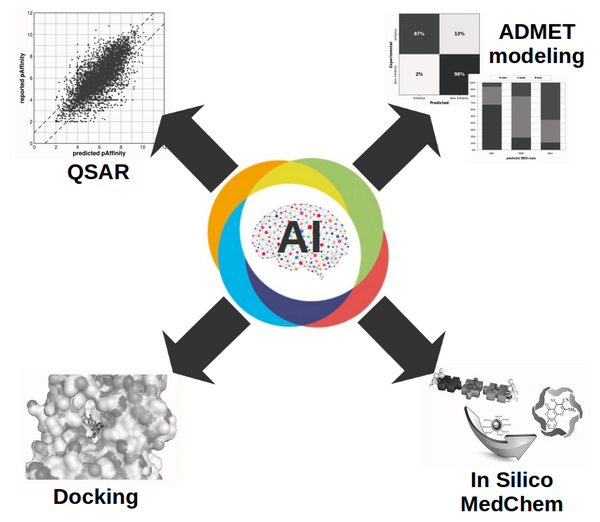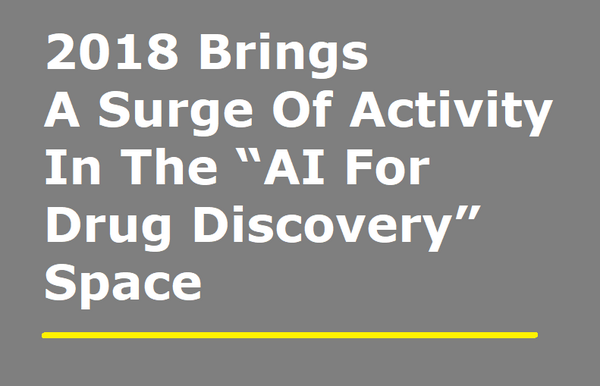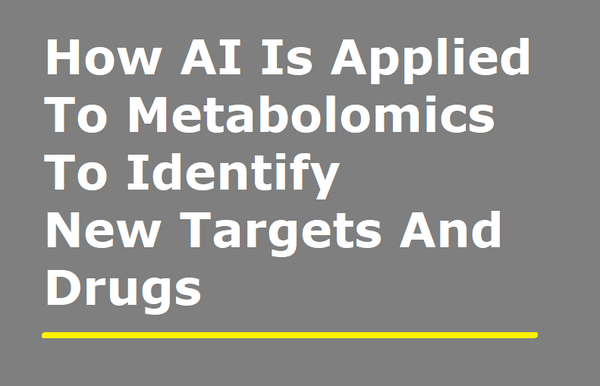The “Why”, “How” and “When” of AI in Pharmaceutical Innovation
(Edited version of this post originally appeared in Forbes)
“It is not the strongest of the species that survives, nor the most intelligent, but the one most adaptable to change” -- Leon C. Megginson
Last year brought about new hope and even more hype around the idea of applying artificial intelligence (AI) for “revolutionizing” drug discovery research -- via machines being able to “learn” chemistry and biology from vast amounts of experimental data to propose potent drug candidates, accurately predict their properties and possible toxicity risks. It is supposed to dramatically minimize failures in clinical trials -- saving R&D budgets, time, and most importantly, lives of patients.
On the one hand, pharmaceutical companies are clearly demonstrating a vivid interest in this technology catalyzed by quite illustrative practical achievements of AI in solving more “traditional” tasks -- winning humans in chess and Go, recognizing speech and text, identifying faces in Facebook photos, driving cars, the list goes on. On the other hand, the history of AI development was filled with ups and downs -- waves of hype around AI were followed by deep frustration and loss of public interest in 70th and 80th of the last century. While now, it seems, the AI technological capacity and big data technologies are all set to usher into the fourth industrial revolution, scepticism is still in the air. Take, for example, recent discussions here, and here and scroll down through commentaries to see how the scientific world has seemingly partitioned into “AI-believers”, “AI-agnostics”, and “AI-atheists”. For many drug discovery professionals, even with a PhD-level expertise in life sciences, the workings of specific AI algorithms remain more of a “black box magic”, and the lack of expertise was found to be among the top barriers for adopting AI by pharma and biotech professionals.
Let’s try to see why pharmaceutical industry is now in need of innovation more than ever, how it can approach AI innovations and how long it will take for the industry transformation to occur.
The first questions is “Why?”
Recently, I came across a relatively simple yet persuasive financial analysis of why pharma industry is in the state of crisis -- and even more than that -- on the brink of a terminal decline. Omitting mathematics behind the scenes, it boils down to a quite natural effect: the more industry improves the standard of care, the more difficult and costly it becomes to improve any further, so pharma organizations end up putting more and more efforts to innovate (R&D cost), to just get diminishing incremental benefits and added value for patients, which results in diminishing overall return on investments (aka “law of diminishing returns”). In other words, all “low-hanging and most profitable fruits” are always taken first, and then it becomes harder and harder to keep pace with improvement.
In the same time, R&D budgets at biopharma companies are usually proportional to revenues. When revenues contract, less money become available for investing back into R&D, leading to even smaller chances of improvement in future with further decline in revenues, etc. -- and so it is a vicious circle, a pharma’s (allegedly) “broken” business model.
The only way out in this situation is the industry’s transformation towards more efficient and less costly innovation models, or even completely new R&D processes in place. Already now, “classical” pharma companies, which has been relying on small molecule drug discovery for decades, are increasingly diversifying product pipelines by introducing biological solutions, such as biologics drugs, cell and gene therapies, tissue engineering and regenerative medicine.
Here is, however, another opportunity for “classical” small molecule pharma to sustain in the challenging economic landscape -- make R&D more productive and less costly -- through adoption of advanced automation and analytics processes powered by various AI-driven algorithms.
The next question is “How”?
The adoption of AI-powered technologies by pharmaceutical companies is challenging mainly due to a talent gap -- a scarce number of research and business professionals with deep technical understanding of both drug discovery foundations and AI-development/implementation skills.
Another challenge is the nature of AI-driven innovation. For instance, when a pharma company comes across a new promising drug target, or a new family of small molecules, those can be fit into the existing R&D workflow, so it is sort of “incremental innovation”. In contrast, AI adoption implies that the very existing R&D and business processes have to be re-designed and automated somehow to harness a synergistic value out of machine learning, big data and high-performance computing infrastructures. It is supposed to be a big-scale organizational transformation. But the truth is, pharma companies are notoriously conservative about their business and research methodologies.
In order to overcome the above challenges, pharmaceutical companies has a lot to learn from technology giants, like Google, Intel, Amazon etc, well known for their flexibility of innovation models.
Below are several tactics of approaching AI-driven innovations for drug discovery:
Drug candidate-as-a-service
A popular R&D outsourcing model includes a collaboration between pharma companies providing certain research data and knowledge (for example, about biological targets), with AI-driven drug discovery startups building up models on top of that knowledge. In the case of any successful drug candidates emerging out of such collaborations, pharma companies license or own those -- depending on the terms of the agreement. In my recent blog post I reviewed some of the key examples of “pharma-AI” collaborations of this kind.
With all the benefits of such business model -- flexibility, cost effectiveness and fast excess to external expertise -- comes certain downsides. For instance, the need to let a third party into the most “intimate” part of the whole drug discovery and development process -- generation of candidate molecules. It is selecting the right partners which becomes the top priority in this case.
Developing internal AI-capabilities
A harder way to go about AI adoption for drug discovery is to try and develop internal expertise and infrastructure for applying AI-algorithms and automation processes. One bold example is GSK’s Insilico Unit -- a research venture organized to explore the potential use cases of AI in GSK’s drug discovery programs and build up internal expertise. Insilico Unit has been also active in collaborating with external AI-experts, including Exscientia and Insilico Medicine.
Importantly, some public cloud service providers are increasingly improving AI/ML capabilities available as a service, thereby eliminating the need for deploying and implementing the entire AI stack from scratch. Such services are available at different levels of abstraction enabling pharma companies to use them to underpin internal expertise with “ready-to-use” machine learning capabilities.
AI intrapreneurship
Such companies as Google and Intel are well known for effectively maintaining intrapreneurship culture, which allows them to constantly innovate and launch new products. Did you know that Gmail was “born” this way?
Essentially, it is all about providing employees with some freedom of creativity and granting them some internal resources for their initiative projects, preferably, without too much bureaucratic hurdles. This approach seems to be a viable strategy of adopting AI innovations for internal drug discovery and development use cases, while .
Business-academia partnerships
Academic research is a driving force of AI innovations and development of new use cases for practical applications. In the same time, a great number of drugs on the market have roots in academic research labs, meaning, that pharma leaders are quite used to betting on research achievements of their academic colleagues. Industry-academia partnerships to identify new biological targets or promising new lead compounds will be growing even further in the context of AI capabilities exploration.
It should be noted, that pharma companies partnering with academia to flair R&D is not the only scenario, AI-driven drug discovery startups are catching up as well. One vivid example is Atomwise which has been actively building relationships with academics through providing its Artificial Intelligence Molecular Screen (AIMS) Award. A hundred scientists have been awarded last year and a new round of awards is already announced for the next term.
Open science projects, R&D challenges
Organizing open science projects and open challenges is a valuable tactics to go about AI adoption (and evaluation) for drug discovery needs in baby steps -- without too much financial risks and responsibilities involved. One such example is QuickFire Challenges by Johnson & Johnson Innovation.
Whatever model is preferred for AI adoption by pharmaceutical organizations, it should remain clear that integration of AI into drug discovery processes is not as much an IT challenge, as it is an R&D challenge. Therefore, the progress can only be achieved by adjusting R&D budgets accordingly, and creating strong interdisciplinary teams of both drug discovery and AI scientists working together. Just throwing some additional bucks at IT departments to have another “company informatization project” is a false approach.
Finally, there is a question “When?”
Indeed, time matters, and the important question for investors and business decision makers is how long it will take for AI in pharmaceutical research to bring desirable return on investments? It is tempting to succumb to overly optimistic expectations -- for instance, after playing with some of the commercially and publicly available tools by Apple (Siri, a personal assistant), Google (Ok, Google feature, Google assistant), etc -- something that was unimaginable in 1970th or 1980th. Clearly, AI has made remarkable progress in the areas of image and video processing, patterns recognition, dealing with natural language, game playing etc.
However, things are fundamentally different (and less optimistic) when it comes to drug discovery, and here is why.
First, the concept validation in pharmaceutical R&D is slow, compared to “pure play” applications. Indeed, when Facebook tags your photo using in-built AI, you can check immediately whether the result is correct or not, thereby notifying the system and making it learn and update models. When AI suggests a new molecule as a potential drug candidate, it might take months and years to prove it efficient (or non-efficient) in a lab and in clinical trials, there is a complex and lengthy learning loop. It slows down the progress in applying AI for this kind of tasks.
Moreover, there is an “innovation versus implementation” gap, which was nicely described in a recent Forbes post by David Shaywitz -- “Winning Health Tech Entrepreneurs Will Focus On Implementation, Not Fetishize Invention”. Basically, a lot of us think of innovation in technology as revelation, which immediately transforms the way of thinking and acting -- which is wrong. While some startling inventions might be popping up in labs on monthly basis, it usually takes a considerable time for the industry to adopt new realms and change globally. Sometimes, decades.
This situation was discussed in details by James Bessen, in his book Learning By Doing. He outlines some of the biggest hurdles to technology implantation at scale as following:
-
A lot of people in different roles will need time to acquire new specialized knowledge, skills, and know-how. Business and research leaders will not get serious about AI until they understand what it is and how to use it.
-
There is a need for adjusting technology itself for becoming user-friendly and applicable to different use cases. For example, specialized machine learning services and tools has to emerge and become mainstream in drug discovery to become widely adopted.
-
Business leaders need time to understand the use cases, and how to adopt new technologies in their wroldflows and workplaces.
-
Time will be needed for new training institutions and new labor markets to emerge and provide the necessary amount of skilled workforce.
In the bottom line, the context of recent AI breakthroughs in different areas provides hope for drug discovery and healthcare as well. However, the timeline for harnessing this value is misunderstood by a lot of hype-generating media and therefore distorts real situation. I think we are talking about at least a 5-10 year period for the drug discovery industry transformation to occur, rather than immediate “disruption”.
Some specific machine learning tools and AI-applications will, however, be widely adopted by drug discovery community in a shorter timelines -- to reduce more routine, time-consuming and resource-intensive tasks.
Key takeaways
-
Emerging AI-driven startups have to focus on implementation strategy and popularization of practical use cases addressing specific drug discovery challenges. stop “fetishizing” innovation.
-
Implementation of AI into drug discovery process is not an IT challenge as much as it is an R&D challenge. And the budgetary spends should be considered from this standpoint.
-
The idea that AI will only be efficient when combined with human expertise have to become central in any collaboration project. AI is not a magic bullet by itself, it is an augmenting instrument to complement human creativity -- at least for now..
-
While certain AI-driven tools are already becoming valuable for different drug discovery applications, the ultimate goal is to have the whole AI-driven integral processes connecting the dots between all the stages of drug discovery and development process. It will take at least 5-10 years to happen.
-
Those pharmaceutical companies who start early with AI adoption will be able to develop strategic advantage over time, and harness value beyond savings.
Join the conversation by leaving your comments below and help others participate by sharing this post.
Topics: Industry Trends Emerging Technologies




Comments:
There are no comments yet. You can be the first.
Leave a Reply cancel reply
Your email address will not be published. Required fields are marked *